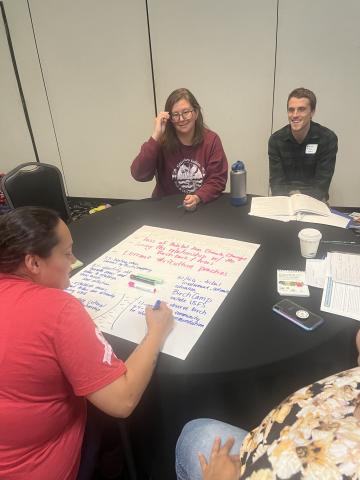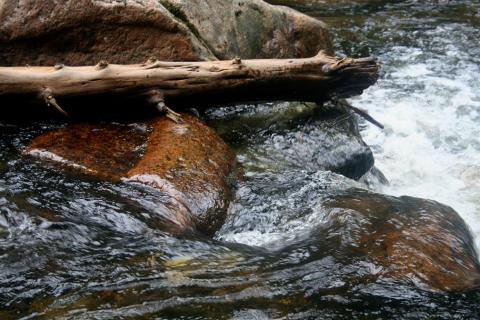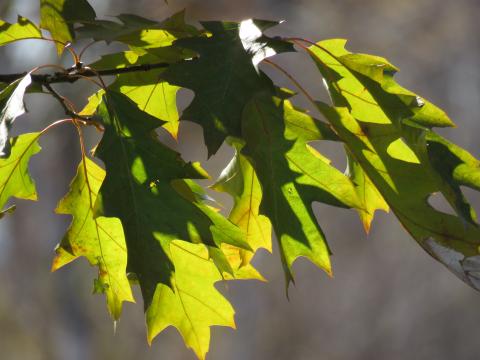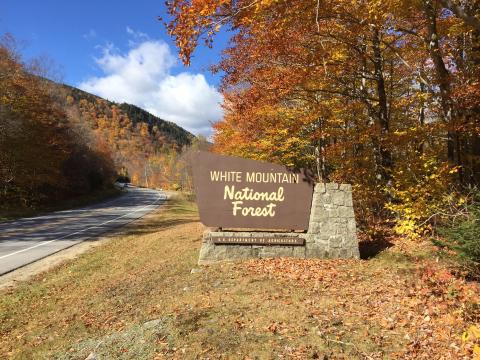2023 Annual Accomplishments of the Northern Forests Climate Hub
The USDA Northern Forests Climate Hub has worked hard throughout Fiscal Year 2023 to provide more outreach and training opportunities to new and familiar audiences, to identify new collaborative opportunities that bring partners together, and to co-produce several products.
Continuing our strong emphasis on technical assistance and hands-on training, we delivered over 40 workshops and field demonstrations, organized 20 webinars, and delivered over 30 presentations, that collectively reached thousands of participants from various perspectives and locations throughout our 20 state service area. Topics included climate change and carbon considerations in forests, oak savannas, watersheds, urban communities, and non-forested wetlands. Audiences included natural resource professionals and land managers from federal and state agencies, Tribes, municipalities, conservation organizations, and industry. Tribal engagement in climate adaptation planning remains a strong emphasis, and we are breaking new ground by using the Tribal Forest Protection Act with regional partners as a vehicle for promoting indigenous values on National Forest land.
Highlights from FY23:
Advancing Tribal Climate Adaptation Priorities Through the Tribal Forest Protection Act
Elevating tribal values through climate change adaptation is one vital way to ensure that federal agencies are honoring our obligations to tribal nations. The USDA Northern Forests Climate Hub, Northern Institute of Applied Climate Science, and tribal partners collaborated to encourage the use of the Tribal Forest Protection Act (TFPA) to advance tribal climate adaptation priorities. Project partners hosted a third TFPA workshop in June 2023, which included over 75 participants from the Red Cliff Band of Lake Superior Chippewa, Bad River Band of Lake Superior Chippewa, and the Chequamegon-Nicolet National Forest. Participants considered projects such as promoting the regeneration of culturally important trees, the indigenous use of prescribed fire, supporting marten habitat across the landscape, and other projects.


Using Forest Service Science to Inform Response to Loss of Elm and Ash
Elm, ash, and other foundational lowland forest tree species face serious health threats from invasive pests and pathogens, land use stresses, and climate change. The loss of these species has threatened city canopies, natural ecosystems, and ways of life for communities that depend on them. Recognizing the fundamental social and ecosystem roles of these species, and to proactively anticipate coming threats to similar keystone trees, scientists at the USDA Forest Service Northern Research Station have worked to identify techniques to preserve, propagate, or replace these species and support the communities that depend on them. The Forest Service researchers enlisted the Northern Forests Climate Hub and Northern Institute of Applied Climate Science to facilitate discussions among scientists and land managers in two conference settings (Baltimore, MD, and Duluth, MN) to discuss the ongoing loss of these species, disseminate research results, and understand real-world operational capacity to respond to these threats.
Tree Species Vulnerability Assessments Support Urban Forest Adaptation
Urban forests provide immense value to people all across the country, and urban forests are exposed to a unique array of stresses from climate change. The USDA Northern Forest Climate Hub provided direct training for urban and community forestry professionals in the greater Boston and Indianapolis regions to integrate climate change vulnerability and adaptation considerations in local projects. American Forests (AF) engaged the Hub and Northern Institute of Applied Climate Science to host workshops to support adaptation planning in urban settings. Participants received training to use Regional Tree Species Vulnerability Assessment publications, AF Tree Equity tools, and the Climate and Health Adaptation Menu resources co-developed by AF, NFCH, NIACS, the USDA Forest Service, and regional partners. Workshop participants received coaching and feedback on their own real-world urban climate adaptation projects.


Balancing Climate, Carbon, and Biodiversity Goals in Wisconsin
Land management actions such as prescribed fire and forest harvesting can sometimes present tradeoffs between achieving ecological outcomes and increasing carbon storage. The Nature Conservancy, the USDA Northern Forests Climate Hub, and the Northern Institute of Applied Climate Science are helping illustrate and describe these potential tradeoffs. Using the Adaptation Workbook planning process, a team of specialists developed adaptation responses that meet biodiversity goals, while also considering the implications of management actions on carbon storage and sequestration. The workshop targeted the TNC Meyer Preserve in southeast Wisconsin with a focus on oak savanna and non-forested wetlands at the Preserve.
Integrating Climate Change into Watershed Planning
Climate change is presenting new vulnerabilities to forested watersheds around the country. The USDA Forest Service is building resilience into landscape-level planning by incorporating climate change considerations into the Watershed Condition Framework (WCF). The FS Eastern Region and FS Office of Sustainability and Climate collaborated with the USDA Northern Forests Climate Hub to host a two-part virtual workshop for regional National Forest watershed specialists to facilitate a process of integrating climate change into Watershed Restoration Action Plans (WRAPs) using readily available data, resources, and tools. The workshop provided technical assistance to USFS Region 9 watershed specialists and introduced a framework for planning in priority watersheds that can assist in the documentation of climate considerations.

Read our quarterly highlights below.
-
1st Quarter Accomplishments

Highlights from October-December 2022.
-
2nd Quarter Accomplishments

Highlights from January-March 2023.
-
3rd Quarter Accomplishments

Highlights from April-June 2023.
-
4th Quarter Accomplishments

Highlights from July-September 2023.
Questions? Contact the USDA Northern Forests Climate Hub staff

